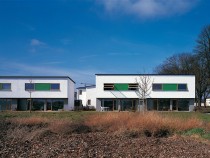
© Peter Bonfig
As a first step in redeveloping the huge areas south of the city that were formerly occupied by military barracks, a development plan was drawn up in a collaboration between the local authorities, the developer and the architects. The present group of newly finished dwellings was created as the outcome of a building society (LBS) competition for the design of a low-cost, environmentally friendly house construction system. The prizewinners, in conjunction with a nominated building contractor, were subsequently required to draw up a fixed estimate of costs. The development is situated on the edge of the former military area adjoining agricultural land. The urban planning of the 20 dwellings conveys a sense of human scale, and the ensemble has a quality reminiscent of village structures, with a central open space and narrow lanes. The high density of the development (floor area to site area ratio in the core area = 0.8) and the varied grouping of the buildings lend the external spaces a clear definition. The small entrance courtyards and the sheds to the L-shaped house type provide an important element of privacy. At first glance, it is not evident that all the houses have an identical ground floor layout and are developed from the same modular construction system. With their varied roof forms and the scope they provide for different groupings, they create the impression of a heterogeneous ensemble.




